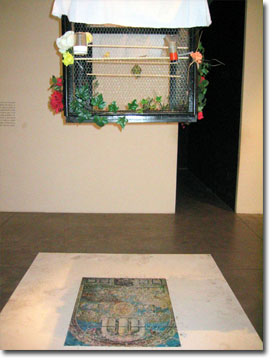Centro Cultural Recoleta ,
Dec 16, 2004 - Feb 27, 2005
Buenos Aires, Argentina
León Ferrari: Retrospective. Works 1954-2004
by Viviana Usubiaga
The layout of the exhibition was constantly changed. Numerous posters warning the public of sensitive material were posted. The attacked works were left as evidence of the intolerance, noting the date of destruction. Several newspaper items, together with letters of support and repudiation, appeared as a postscript to the exhibition, that is, part of the abundant documentation generated before and during this retrospective.
Follow-up on the controversy can be found on Ferrari's website. Suffice to say that a number of issues have remained open. Beyond those mentioned, a strange sensation remains with respect to the quality of the public opinion generated, given the nature of the coverage. If one thinks of the enormous publicity generated not for the exhibition, as had been thought but for the Church itself and the most conservative sectors of society, it is clear that no opportunity for distraction was neglected. The ecclesiastical institutions did not pass up an opportunity to demonstrate to the faithful its active preoccupation in the face of what it considered malicious external attacks on its sacred values and to encourage its congregation to mobilize. Meanwhile, the silence surrounding recent public scandals of pedophilia within its institutions at a time when it's also exercising its influence to prevent sex education in schools in Buenos Aires is an interesting comparison. On another matter, even though the outdated conceptions of art published by some of the critics were not surprising, one must note the markedly backward discussions that have appeared in the press. Even though many intellectuals have written solid essays in defense of the exhibition, no other intelligent criticism was produced by other media. Detractors have not generated an argument that was not dogmatic repetition or defense of cult imagery, which is connected less with expressing an opinion on artistic representation than with repressing the choice on whether or not to visit an art exhibition. Paradoxically, it was necessary to ask that conflicts that might divide society be avoided, ignoring the fact that society is effectively divided ("between the hungry and the satiated"), by many of the problems that Ferrari's work has denounced for decades.
While finishing this article, a letter from the artist was made public in which he suggested the closure of the exhibition. With over 50,000 people attending the show, added to the over 400 press articles and ongoing debates, the expectations of the retrospective have been more than met. Some of the works there refer to anti-Semitism, birth control and the struggle against AIDS, the Western attitude towards sex, misogyny, the Conquest, the Inquisition and the activities of the U.S. in Vietnam and Iraq. These works gave rise to an intense and necessary debate that promises to continue and to expand. Society has shown that it is willing to discuss these subjects and to go over the restrictions and inquiries implicit in the works exhibited and, in art in general. The attacks, the closure of the exhibition for ten days, together with the bomb threats which made it necessary to evacuate the entire Centro Cultural Recoleta and the OEA building on several occasions, created an atmosphere of tension, which affects the normal workings of any institution. For these reasons, the progress achieved by the exhibition and the daily difficulties the exhibition raises, implying a personal and collective effort and stress, it appears prudent and timely to shorten the original period (7). The director of the cultural center, Nora Hochbaum, in agreement with the decision was content with having established precedents in the jurisprudence on freedom of expression, the relationship between art and religion, art and the law, and the State and Church. In any case, a few museums in the Argentine provinces have expressed an interest in taking the Retrospectiva to their cities, as has the director of the Pinacoteca of Sío Paulo, Brazil. The showcase will, without doubt, form part of one of the most turbulent chapters in the history of Argentine art. As Michel Foucault once said, "The work of an intellectual consists not of modeling the political will of others, but lies rather in questioning, by means of the analyses carried out in his own terrain, the evidence and the positions taken, in renovating the habits, the ways of acting and thinking, in dissipating the familiarities permitted in retaking the measure of rules and institutions and, based on this upheaval, (in which one's specific trade of intellectual is developed) to take part in the formation of a political will (in which he is able to play his role of citizen)"(8). An agitator of forms, profane interpreter of the Scriptures, precocious expert and daring artist, León Ferrari personifies the new ethics-aesthetics of existence.
Notes:
1) Andrea Giunta, ‘Perturbadora belleza’ in León Ferrari. Retrospectiva. Obras 1954-2004, cat. exp., ed. Centro Cultural Recoleta – Malba, Buenos Aires, 2004, p.23.
2) León Ferrari, ‘Berimbau’, San Pablo, September 1979. Reproduced in ibid., p.304.
3) Andrea Giunta, op.cit., p.20.
4) Arturo Carrera, Animaciones suspendidas, Buenos Aires, Editorial Losada, 1986.
5) Luis Camnitzer, ‘Letrinas, letrados y letras’, in cat.cit., p.46.
6) Michel Foucault, ‘The Subject and the Power’, in Wallis & Tucker (comp.), Art After Modernism. Rethinking Representation, New York, The New Museum of Contemporary Art, 1984, pp.417-432. Originally published by H.L.Dreyfus & P.Rabinow, Michel Foucault: Beyong Structuralism and Hermeneutic, The University of Chicago Press, 1982.
7) Letter from León Ferrari to Nora Hochbaum, 23 January, 2005.
8) Michel Foucault, Saber y verdad, La Piqueta, Madrid, 1985, pp.229.
|













